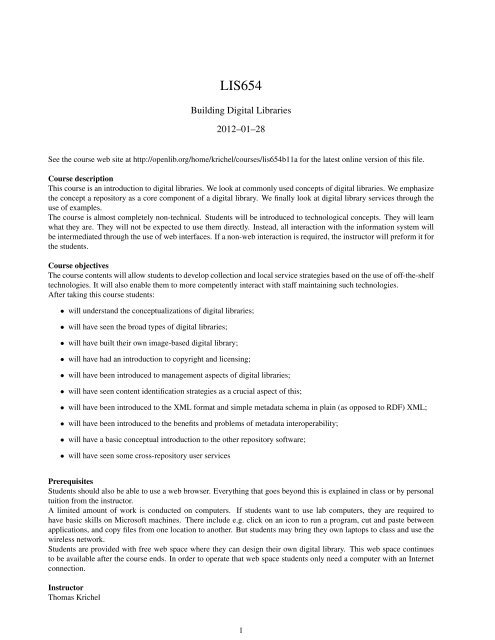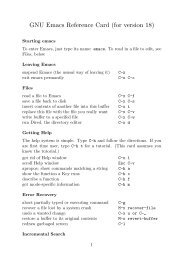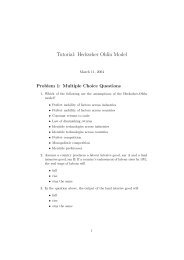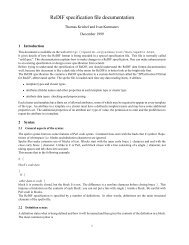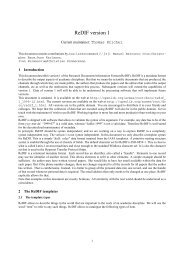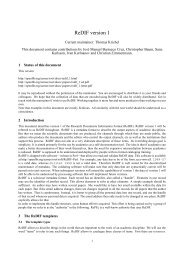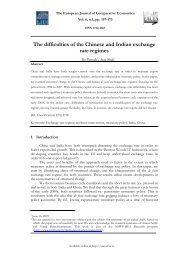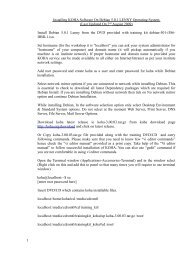LIS654 - Open Library Society, Inc.
LIS654 - Open Library Society, Inc.
LIS654 - Open Library Society, Inc.
Create successful ePaper yourself
Turn your PDF publications into a flip-book with our unique Google optimized e-Paper software.
<strong>LIS654</strong><br />
Building Digital Libraries<br />
2012–01–28<br />
See the course web site at http://openlib.org/home/krichel/courses/lis654b11a for the latest online version of this file.<br />
Course description<br />
This course is an introduction to digital libraries. We look at commonly used concepts of digital libraries. We emphasize<br />
the concept a repository as a core component of a digital library. We finally look at digital library services through the<br />
use of examples.<br />
The course is almost completely non-technical. Students will be introduced to technological concepts. They will learn<br />
what they are. They will not be expected to use them directly. Instead, all interaction with the information system will<br />
be intermediated through the use of web interfaces. If a non-web interaction is required, the instructor will preform it for<br />
the students.<br />
Course objectives<br />
The course contents will allow students to develop collection and local service strategies based on the use of off-the-shelf<br />
technologies. It will also enable them to more competently interact with staff maintaining such technologies.<br />
After taking this course students:<br />
• will understand the conceptualizations of digital libraries;<br />
• will have seen the broad types of digital libraries;<br />
• will have built their own image-based digital library;<br />
• will have had an introduction to copyright and licensing;<br />
• will have been introduced to management aspects of digital libraries;<br />
• will have seen content identification strategies as a crucial aspect of this;<br />
• will have been introduced to the XML format and simple metadata schema in plain (as opposed to RDF) XML;<br />
• will have been introduced to the benefits and problems of metadata interoperability;<br />
• will have a basic conceptual introduction to the other repository software;<br />
• will have seen some cross-repository user services<br />
Prerequisites<br />
Students should also be able to use a web browser. Everything that goes beyond this is explained in class or by personal<br />
tuition from the instructor.<br />
A limited amount of work is conducted on computers. If students want to use lab computers, they are required to<br />
have basic skills on Microsoft machines. There include e.g. click on an icon to run a program, cut and paste between<br />
applications, and copy files from one location to another. But students may bring they own laptops to class and use the<br />
wireless network.<br />
Students are provided with free web space where they can design their own digital library. This web space continues<br />
to be available after the course ends. In order to operate that web space students only need a computer with an Internet<br />
connection.<br />
Instructor<br />
Thomas Krichel<br />
1
Palmer School of <strong>Library</strong> and Information Science<br />
C.W. Post Campus of Long Island University<br />
720 Northern Boulevard<br />
Brookville, NY 11548–1300<br />
krichel@openlib.org<br />
work phone: +1–(516)299–2843<br />
skype: thomaskrichel<br />
Class structure<br />
Classes are held in room 122 on the Brentwood campus on Thursdays between 18:20 and 20:10. Between classes,<br />
support via the class mailing list will be available.<br />
Each class has a presentation by the instructor. Students are expected to do some of the the work on their digital libraries<br />
at home.<br />
Class details<br />
Here are some class details:<br />
2011–09–08 18:20 to 20:10 introduction: from physical to digital libraries<br />
2011–09–15 18:20 to 20:10 origins of digital libraries and origins of repositories<br />
2011–09–22 18:20 to 20:10 repository planning<br />
2011–09–29 18:10 to 20:10 getting to work with Omeka: installation and system overview<br />
2011–10–06 18:10 to 20:10 omeka themes and example plugin<br />
2011–10–13 18:10 to 20:10 omeka metadata and tables<br />
2011–10–20 18:10 to 20:10 presentation of project plan<br />
2011–10–27 18:10 to 20:10 digital imaging<br />
2011–11–03 18:10 to 20:10 presentations on plugins<br />
2011–11–10 18:10 to 20:10 copyright basics I<br />
2011–11–17 18:10 to 20:10 copyright basics II<br />
2011–12–01 18:10 to 20:10 software solutions for repositories and repository interoperability (lis654b11a-11.pptx)<br />
) 2011–12–08 18:10 to 20:10 cross-repository services )<br />
Slides for all classes can be downloaded from the course web site. The slides on the course website are drafts until the<br />
commencement of the class.<br />
Reading<br />
If students want to consult a textbook, Reese Jr and Barnerjee (2008) is a reasonable, but book. Consult the instructor<br />
about access options before buying it.<br />
A simple, dated, but well-written book is Arms (2005).<br />
Web sites used<br />
The National Information Standards Organization has a Framework of Guidance for Building Good Digital Collections.<br />
The <strong>Library</strong> of Congress maintains the Metadata Encoding & Transmission Standard: Official Site and the Metadata<br />
Object Description Schema: Official Site.<br />
Cornell University bring us the Digital Imaging Tutorial 1 .<br />
Omeka is a project of the Roy Rosenzweig Center for History and New Media at George Mason University. Look at<br />
the Omeka Showcase. A simple example of what is doable for a class site is Bridget Harmon’s site about the Middle<br />
Village Lutheran Cimetery 2 . and Julianna Monjeau’s site about The Kosher Meat Boycott of 1902. There is<br />
an official list of sites using omeka.<br />
DuraSpace maintain DSpace.<br />
Long Island Memories provide sample simple digital collections we intend to reproduce.<br />
For images, there are useful web sites Aware Systems provide Information about TIFF. Greg Roelofs provides information<br />
about PNG.<br />
Background readings<br />
Digital libraries are built by building them, not by reading about them.<br />
On early history, Bush (1945) is a standard reference but it is overrated. Licklider (1965) is much better work in the same<br />
direction. You may also enjoy Licklider (1960), Licklider (1968), and Hauben (2005). On more modern approaches to<br />
1 http://www.library.cornell.edu/preservation/tutorial/<br />
2 http://brigidharmon.com/lutherancemetery/<br />
2
such early systems, see Schatz (1997). On repository history, you may consult historic papers of Van de Sompel, Krichel,<br />
Nelson, Hochstenbach, Lyapunov, Maly, Zubair, Kholief, Liu, and O’Connell (2000) and Davis and Lagoze (2000).<br />
Harter (1996) is an early paper on digital libraries. Borgman (1999) has more about different digital library concepts.<br />
Lynch (2005) demonstrates good thinking about directions in digital libraries that are worth discussing if they have<br />
become reality.<br />
On copyright, the main reference is Hirtle, Hudson, and Kenyon (2009). We have other useful material in Copyright Office<br />
(2010), Bennett (1999) and Templeton (2008).<br />
On XML, see the lecture notes of Thomas Krichel lis650 course, as well as the wonderfully short piece of Taylor (2004a).<br />
For more theoretical perspective, musings of Janisch (2002) and Pitti (2002) are available.<br />
For metadata, Taylor (2004b) gets it right again. Foulonneau and Riley (2008) provides a general introduction. On<br />
METS we have a good background paper by McDonough (2006). Taylor (2004a), Taylor (2004b),<br />
On the topic of Omeka, we mainly use its web site, but some favorable review by Kucsma, Reiss, and Sidman (2010)<br />
may provide inspiration.<br />
When we turn to digital repositories, we will mainly use Lynch (2003) Brown, Griffiths, and Rascoff (2007) for background<br />
and <strong>Inc</strong>. (2011) for how to get things done.<br />
To see how complicated persistent and digital preservation can be, a peek at Consulative Committee for Space Data<br />
Systems (2002)<br />
On identifiers, see Kunze (2008) Lynch (2001) Berners-Lee (1998) and Tonkin (2008)<br />
Last, but by no means least, there is a bunch of home-grown resourceshttp://openlib.org/home/krichel/courses/lis654.<br />
Mailing list<br />
There is a mailing list for the course at https://lists-1.liu.edu/mailman/listinfo/cwp-lis654-krichel. All students are encouraged<br />
to subscribe. As a rule, answers to email sent to the instructor are copied to the list. There are exceptions to<br />
this rule:<br />
• if the question writer requests the answer not to be posted;<br />
• if the question is a purely private matter.<br />
Assessment<br />
Students have a quiz every class bar the first one, and bar the two sessions where the presentations are due. The first<br />
presentation is on the project plan on 2011–10–06. The second introduces a plugin of the students choice, but different<br />
for each student, on 2011–10–27. Student upload their presentation materials to their web site (as opposed to their<br />
omeka sites). For this a roster is available, where the plugin per student is recorded. The four worst performances will<br />
be discounted. The average of all quizzes accounts for 10/30 all of the final grade. The quizzes related to all Palmer<br />
School objects relevant for the course. Students prepare a small image-based digital library, of 10 to 20 images. This has<br />
to be finished by week 10. It will account for 10/30. Finally, there is the assessment of an institutional repository. Each<br />
student will be given one institutional repository URL, and a set of metadata records from that repository. The student<br />
assesses the content, and the description of the contents. The paper can be quite descriptive. It should not exceed three<br />
printed page or 1000 words. It counts for 8/30. It has to be handed at the second before last class meeting.<br />
Students<br />
Gina P. Russo: home omeka project plan plugin presentation<br />
Donna Triolo: home omeka project plan plugin presentation<br />
Colleen Friel: home omeka project plan plugin presentation<br />
Christine Leddy: home omeka<br />
plugin presentation<br />
Catherine Gorden: home omeka project plan plugin presentation<br />
Rebecca Goldstein: home omeka project plan plugin presentation<br />
Fabio Montella: home omeka project plan plugin presentation<br />
James R. Griffin: home omeka project plan plugin presentation<br />
Deborah de Bruin: home omeka project plan plugin presentation<br />
Amanda Paduano: home omeka project plan plugin presentation<br />
Jennifer McHugh: home omeka project plan plugin presentation<br />
Lisa Zimmermann: home omeka<br />
plugin presentation<br />
John LoGiudice: home omeka project plan plugin presentation<br />
3
References<br />
Arms, William Y. (2005). Digital Libraries. available at http://www.cs.cornell.edu/wya/diglib/MS1999.<br />
Bennett, Scott (1999). Authors’ Rights. Journal of Electronic Publishing 5. available at http://hdl.handle.net/2027/sp<br />
o.3336451.0005.203.<br />
Berners-Lee, Tim (1998). Cool URIs don’t change. available at http://www.w3.org/Provider/Style/URI.<br />
Borgman, Christine L. (1999). What are digital libraries? Competing visions. Information Processing and Management<br />
38(3), 227–243. available at http://local.openlib.org/home/krichel/courses/read/borgman99_what.pdf.<br />
Brown, Laura, Rebecca Griffiths, and Matthew Rascoff (2007). University Publishing In A Digital Age. available<br />
http://www.ithaka.org/ithaka-s-r/strategyold/Ithaka%20University%20Publishing%20Report.pdf.<br />
Bush, Vannevar (1945). As We May Think. The Atlantic Monthly 176(1). available at http://www.theatlantic.com/ma<br />
gazine/archive/1945/07/as-we-may-think/3881/.<br />
Consulative Committee for Space Data Systems (2002). Reference Model for an <strong>Open</strong> Archival Information System<br />
(OAIS). available at http://ddp.nist.gov/refs/oais.pdf.<br />
Copyright Office, <strong>Library</strong> of Congress (2010). Copyright Basics. available at http://www.copyright.gov/circs/circ1.p<br />
df.<br />
Davis, James R and Carl Lagoze (2000). NCSTRL: design and deployment of a globally distributed digital library.<br />
Journal of the American <strong>Society</strong> for Information Science 51(3), 273–280. available at http://openlib.org/home/kri<br />
chel/courses/lis654/readings/davis00_ncstr.pdf.<br />
Foulonneau, Muriel and Jenn Riley (2008). Metadata for digital resources. Chandos. first part available at http://loca<br />
l.openlib.org/home/krichel/courses/read/foulonneau08_metad_1.pdf, second part available at http://local.openlib.<br />
org/home/krichel/courses/read/foulonneau08_metad_2.pdf.<br />
Harter, Stephen P. (1996). What is a Digital <strong>Library</strong>? Definitions, Content, and Issues. available at http://php.indiana.<br />
edu/~harter/korea-paper.htm.<br />
Hauben, Jay R. (2005). Vannevar Bush and JRC Licklider: Libraries of the Future 1945–1965. available at http://ww<br />
w.columbia.edu/~hauben/lof-final05.doc.<br />
Hirtle, Peter B., Emily Hudson, and Andrew T. Kenyon (2009). Copyright and Cultural Institutions: Guidelines for<br />
Digitization for U.S. Libraries, Archives, and Museums. eCommons@Cornell. availble at http://ecommons.librar<br />
y.cornell.edu/bitstream/1813/14142/2/Hirtle-Copyright_final_RGB_lowres-cover1.pdf.<br />
<strong>Inc</strong>., DuraSpace (2011). DSpace 1.7.1 Documentation. available at http://www.dspace.org/1_7_1Documentation/.<br />
Janisch, Troy (2002). What the Hell is XML? avaible http://www.alistapart.com/articles/hellxml/.<br />
Kucsma, Jason, Kevin Reiss, and Angela Sidman (2010). Using Omeka to Build Digital Collections: The METRO<br />
Case Study. D-Lib Magazine 16(3/4).<br />
Kunze, John A. (2008). Towards Electronic Preservation Using ARK Identifiers. https://confluence.ucop.edu/display<br />
/Curation/ARK.<br />
Licklider, Joseph Carl Robnett (1960). Man-Computer Symbiosis. IRE Transactions on Human Factors in Electronics<br />
HFE-1, 4–11. available at http://openlib.org/home/krichel/courses/lis654/readings/licklider60_man_comput_<br />
symbios.pdf.<br />
Licklider, Joseph Carl Robnett (1965). Libraries of the Future. M.I.T. Press. available at http://local.openlib.org/hom<br />
e/krichel/courses/lis654/readings/licklider65_librar_futur.pdf.<br />
Licklider, Joseph Carl Robnett (1968). The Computer as a Communication Device. Science and Technology. available<br />
at http://openlib.org/home/krichel/courses/lis654/readings/licklider68_comput_commun_devic.pdf.<br />
Lynch, Clifford (2001). Identifiers and Their Role in Networked Information Applications. available at http://www.a<br />
rl.org/bm~doc/identifier.pdf.<br />
Lynch, Clifford (2003). Institutional Repositories: Essential Infrastructure for Scholarship in the Digital Age. http://s<br />
cholarship.utm.edu/21/1/Lynch,_IRs.pdf.<br />
Lynch, Clifford (2005, July). Where Do We Go From Here?: The Next Decade for Digital Libraries. Digital Libraries<br />
Magazine. available at http://www.dlib.org/dlib/july05/lynch/07lynch.html.<br />
McDonough, Jerome (2006). METS: standardized encoding for digital library objects. available at http://hdl.handle.n<br />
et/2142/177.<br />
Pitti, Daniel V. (2002). Introduction to XML. available at http://www.iath.virginia.edu/~dvp4c/xmlintro.html.<br />
4
Reese Jr, Terry and Kyle Barnerjee (2008). Building Digital Libraries. How-to-do-it manual no 153. Neal-Schuman.<br />
first part available at http://local.openlib.org/home/krichel/courses/read/reese08_build_digit_librar0-4.pdf, second<br />
part available at http://local.openlib.org/home/krichel/courses/read/reese08_build_digit_librar5-10.pdf.<br />
Schatz, Bruce R. (1997). Information Retrieval in Digital Libraries: Bringing Search to the Net. Science 275, 327–<br />
333. available at http://openlib.org/home/krichel/courses/lis654/readings/schatz97_infor_retriev_digit_librar.pdf.<br />
Taylor, Mike (2004a). All You Need to Know about XML in One Page. available at http://www.miketaylor.org.uk/te<br />
ch/xml.html.<br />
Taylor, Mike (2004b). One Man’s Ceiling is Another Man’s Floor—or—Why your data may not be as meta as you<br />
think it is. available at http://www.miketaylor.org.uk/tech/metadata.html.<br />
Templeton, Brad (2008). 10 Big Myths about copyright explained. available at http://www.templetons.com/brad/cop<br />
ymyths.html.<br />
Tonkin, Emma (2008). Persistent Identifiers: Considering the Options. Ariadne.<br />
Van de Sompel, Herbert, Thomas Krichel, Michael L. Nelson, Patrick Hochstenbach, Victor M. Lyapunov, Kurt<br />
Maly, Mohammad Zubair, Mohamed Kholief, Xiaoming Liu, and Heath O’Connell (2000). The UPS Prototype<br />
An Experimental End-User Service across E-Print Archives. D-Lib Magazine 6(2). available at http://www.dlib.o<br />
rg/dlib/february00/vandesompel-ups/02vandesompel-ups.html.<br />
5


